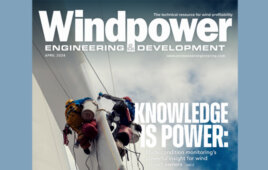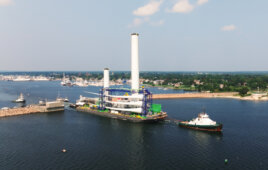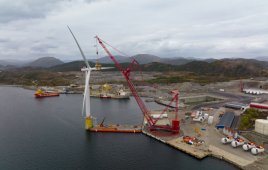Ron Fukui / PSI Director of Engineering and Technology / PSI Repair Services Inc / www.psi-repair.com
As a supplier of wind-turbine component repairs and remanufacturing services to the wind industry, we see failed components from many wind farms. During their repairs, we can often identify trends that can be halted with appropriate corrective measures. To illustrate, let’s examine the preventable failure to an AEBI board from a GE 1.5-MW turbine.
The problem
The board provides firing signals to an AEBM board which is located on another with Insulated Gate Bipolar Transistors or IGBTs. An IGBT is a three terminal, power-semiconductor device used as an electronic switch that combines high efficiency and fast switching. However, the devices generate heat and so require cooling.
Corrosion is a common cause of failure for an AEBI board after it is inadvertently exposed to the harsh coolant required for the warm-running IGBTs. Replacing faulty IGBTs call for removing their cooling lines, which often lets coolant flow down the electrical cables or splash onto AEBI boards. Over time, the coolant causes failure by corroding the tracks and components on the AEBI board.
Six connectors on AEBI boards hook up to the IGBTs. These connectors and cables, designated P1 through P6, provide a path for the fluid to the insulation at the back of the AEBI board. The lower left image shows the location of these components as they relate to each other.
The latter three pictures provide evidence of additional fluid contamination at several
locations on the boards. For instance, the blue residue visible on AEBI board connector header, is antifreeze. (Right) You can see that removing a tube would let the coolant (antifreeze) drip and travel down the white cables and find its way to the bottom of the header where it contacts and corrodes connector pins. To make matters worse, this header is not completely sealed at the bottom, so fluid eventually seeps through to a circuit board, causing corrosion damage to its traces.
In the lower left picture, the connector header has been removed from the AEBI board pictured above it. The bottom three barrels (holes) have been badly corroded by the antifreeze. As a result, the board cannot be returned to serviceable condition.

Removing the connector header from the previous image shows that corrosion has progressed to the surface of the board.
The final image (below right) shows damage that occurs to integrated circuits (IC) in close proximity to
the connector headers. In this example, fluid from the connector has made its way to the IC legs and provides a path for current, causing erroneous faults or control problems. Corrosion has also damaged the connector legs and pads for the IC. If the contamination is allowed to attack the components for an extended period of time, it will ultimately render the board un-repairable, as well as disable the turbine.
The solution
So how can maintenance technicians stop contaminations on AEBI boards during IGBT replacements? By simply first covering the AEBI boards with a layer of plastic or clean rags before removing coolant lines to the heat sink.
Procedural changes in operations and maintenance can prevent early failures and keep existing cores in serviceable condition. Wind farms can increase equipment availability and lower their maintenance costs by following best-practice guidelines and working closely with their repair provider to help boost the efficiency of the wind-turbine equipment.
There are many uncontrollable failure modes which result in equipment downtime. But in some instances, failures are completely avoided through corrective measures. Wind farms that seek root causes and embrace corrective measures will gain a long-lasting competitive advantage. WPE
Filed Under: Featured









PSI looks like a good outfit. I guess the AEBI and AEBM boards are in the power electronics. It would be best to eliminate this component from wind turbines. DeWind has been doing it for a decade with their D8.2 and now the D9.2. But the industry should develop a better variable-to-constant speed device than the one DeWind is using.